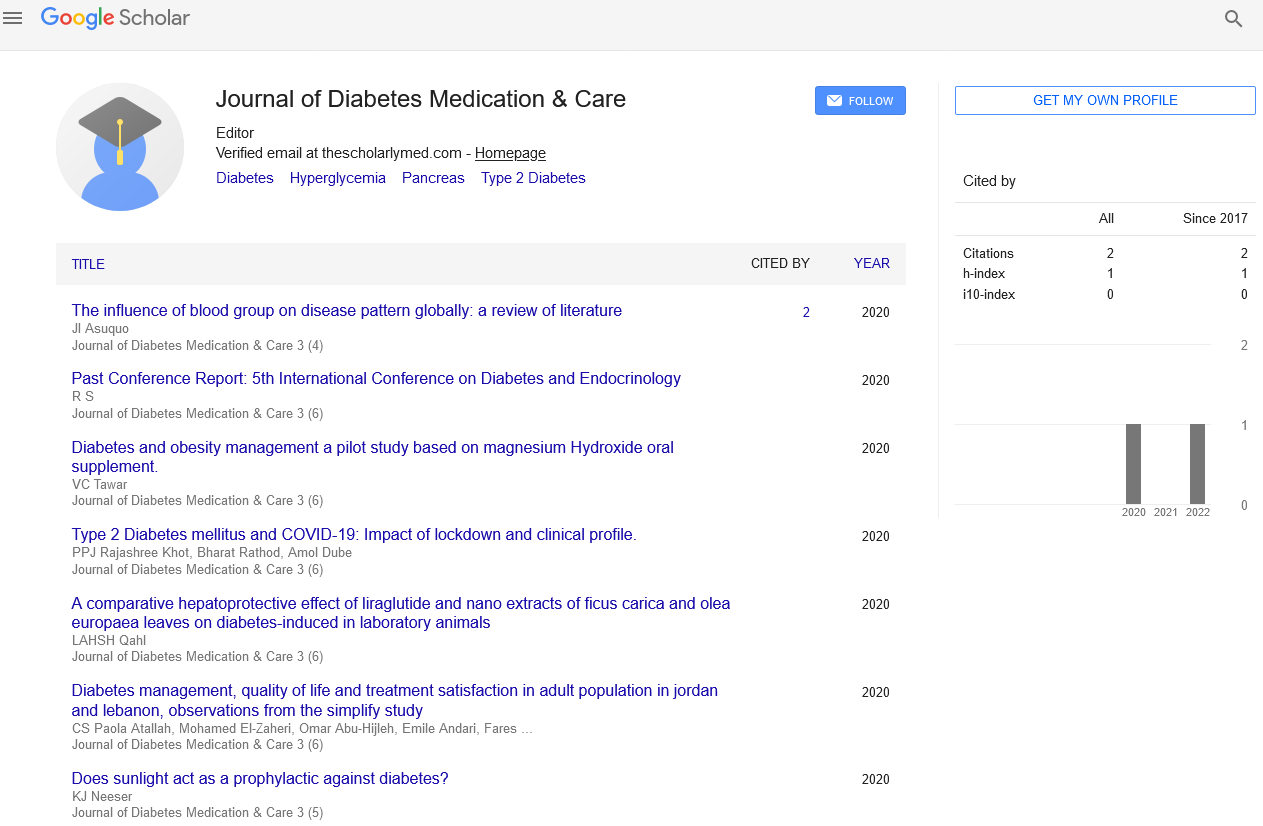Editorial - Journal of Diabetes Medication & Care (2022) Volume 5, Issue 5
Defining a Healthy Diet: Contemporary Dietary Patterns in Health and Disease
Dr. Raziya Rhamanur*
Department of Diabetes Medication, University of Science & Technology, Pakistan
Department of Diabetes Medication, University of Science & Technology, Pakistan
E-mail: raziya.rhamanur@gmail.com
Received: 28-Sep-2022, Manuscript No. JDMC-22-79033; Editor assigned: 01-Oct-2022, PreQC No. JDMC-22-79033; Reviewed: 10-Oct-2022, QC No. JDMC-22-79033; Revised: 17-Oct-2022, Manuscript No. JDMC-22-79033 (R); Published: 28-Oct-2022; DOI: 10.37532/jdmc.2022.5(5).76-79
Abstract
Nutrients and other bioactive constituents of foods may interact with each other and the surrounding food matrix in complex ways. Therefore, associations between single nutrients and chronic disease may be difficult to identify and interpret, but when dietary patterns (DPs) are examined the combination of many food factors will be considered. An explorative literature search of published review articles was conducted to obtain a fuller understanding of current DPs in epidemiological research, to discuss pros and cons of DPs in nutrition research, and to identify results of studies linking DPs to chronic disease risk in adults. Randomized feeding trials providing the experimental diets to study participants have repeatedly demonstrated that diets based on current dietary recommendations are associated with important health benefits. Systematic reviews of feeding trials and prospective population studies of DPs and chronic disease risk reach similar conclusions regardless of the methodology used to construct DPs. However, to date only a few review articles of DP studies have followed a systematic process using independent reviewers with strict inclusion, exclusion, and study quality criteria. Diets with plenty of plants foods, fish, and seafood that preferably include vegetable oils and low-fat dairy products are associated with a lower risk of most chronic diseases. In contrast, Western-type DPs with food products low in essential nutrients and high in energy, like sugar-sweetened beverages, sweets, refined cereals and solid fats (e.g. butter), and high in red and processed meats, are associated with adverse health effects. An emphasis on high-quality original research, and systematic reviews following a structured process to objectively select and judge studies, is needed in order to enforce a strong future knowledge base regarding DPs and chronic disease. It is argued that nutrition studies choosing a traditional nutrient specific approach may underestimate the total health impact of natural foods, and could lead to inaccurate interpretations of study outcomes resulting in the formulation of erroneous dietary advice.
Introduction
The very high dosages and different chemical forms of nutrients contained in supplements [1], compared to the nutrients in natural foods, likely contribute to the disappointing results of randomized clinical trials, initiated to confirm the dietary importance of nutrients like beta-carotene or vitamin E. Studies also report that supplement use may have adverse health effects. In contrast, carefully conducted intervention studies have demonstrated the efficiency and advantage of whole diet trials when searching for preventive strategies to chronic disease [2].
The increasing awareness of difficulties when searching for the impact of single nutrients in nutrition epidemiology have stimulated researchers to explore the health effect of food item combinations that is food or dietary patterns (DPs) [3], and to argue for a more holistic approach to nutrition research for biological as well as statistical reasons. However, with accumulating experiences, researchers have raised problematic methodological issues when constructing DPs. Others debate whether more refined approaches are needed considering the complexity of diet and differences in disease etiologies. In order to obtain a fuller understanding of the current view of DPs in epidemiological research using either data-driven methods or dietary indexes, the purpose of this report was to explore review articles regarding DP studies [4]. The specific aims were to discuss the pros and cons of DP studies, including considerations of dietary complexities and methodological issues, and to identify and discuss the results of systematic review articles of studies among adults linking DPs to chronic disease risk. Experimental, clinical, and epidemiological nutrition research has traditionally strived to identify the specific mechanisms and health effects of single nutrients. However, because each food item contains energy, essential nutrients, and a multitude of bioactive substances that interact with each other and the surrounding food matrix in complex ways, the search for associations between single food factors and chronic disease may be difficult and confusing [5].
Methods
The present literature review is a part of the project reviewing and updating the scientific basis in preparation for the fifth version of the Nordic Nutrition Recommendations (NNR). The foci of the NNR project are those areas where new scientific knowledge has emerged since the fourth edition, with special relevance for the Nordic setting [6]. A number of systematic literature reviews (SR) will form the basis for establishment of dietary reference values in the fifth edition of NNR. However, the literature review presented in the current paper is not a SR, but the result of an explorative literature search based on the research questions and the search string displayed. The majority of review papers identified in the literature search did not focus on specific endpoints, but were general or narrative reviews discussing the rationale for the DP approach in nutrition research, or describing the process of constructing DPs, or discussing methodological issues regarding a priori or a posteriori DP approaches [7]. These articles are cited in several sections of this paper, but are mostly found under the heading ‘DPs in observational studies. Because individuals consume combinations of foods, nutrient intakes are inter-correlated, which causes problems in statistical analysis and in the interpretation of nutritional epidemiology studies. When strongly correlated nutrient variables are entered simultaneously in the same statistical model, the independent variation of a single nutrient is markedly reduced; as a result associations with disease endpoints in epidemiological studies tend to be attenuated. On the other hand, when examining each nutrient variable separately (i.e. when conducting many statistical tests), the likelihood of observing statistically significant associations by chance is enhanced. Also, since single nutrient analysis does not take complex synergistic interactions into account, the dietary health effect of a single nutrient may be too small to detect. When DPs are examined, however, many dietary components in the same pattern could result in sufficiently large cumulative effects that would enhance detection [8]. Also, when examining single nutrients there is always some risk of confounding by other nutrients of food factors found in the same dietary pattern [9]. Thus by constructing and analyzing food patterns the co-linearity of foods is turned into an analytical advantage, while simultaneously enhancing the analytical ability to observe the total health impact of diet. However, researchers also recognize that chronic diseases have many facets and complex etiologies and that the scrutiny of the pathophysiological processes is difficult [10].
Conclusion
The contrast to these plant food based diets is the Western pattern, which is common in westernized counties but spreading worldwide at a fast pace. Most of the studies using a posteriori approaches identified Western DPs as being related to increased risk of cardiovascular and metabolic diseases and to colon cancer. The specific food choices of the Western DP may vary slightly across populations, but the general characteristics are the dominance of red and processed meats, ‘junk foods’, refined cereals, confectionaries, sweets, sugar-containing beverages, and ultraprocessed foods manufactured by the food industry. Biomarker studies have demonstrated that the Western DP is associated with low concentrations of micronutrients and likely provides less of other bioactive substances with health benefits found in plant foods. However, the Westernized DP also includes many processed and ultra-processed foods that likely contribute components with potential adverse health effects; those added during the manufacturing process (like transfatty acids) or formed during prolonged heat treatment (like heterocyclic amines, acryl amide, or advanced glycation/lipidoxidation end-products, AGE/ALE). Studies within EPIC (European Prospective Investigation into Cancer and Nutrition) indicate that the use of manufactured food products currently (i.e. data collected in the 1990s) is higher in northern European countries than in Mediterranean countries. However, researchers argue that the traditional diets of the Nordic countries have important health advantages, and many projects currently examine the health influences of components of Nordic diets. Since the health impact of a modern healthy Nordic DP has only been examined to a limited extent so far, the EPIC observations emphasize the need to strengthen this line of research. It should be noted that the identified review articles overlap. Since they review the same subject area during the same time period, it was expected that the same original research articles would be cited by many reviews. The conclusions should therefore not be interpreted in a cumulative sense. Several review papers identified that inconsistent results across studies were likely due to design weaknesses of the original research studies. Incomplete information also contributed to difficulties in interpreting study findings. It should be noted that in those articles where fuller study descriptions were provided and where design issues were not major obstacles, the overall conclusions were similar regardless of DP approach and specific disease end point. Only a few of the identified review articles were, in a strict sense, SRs, following processes similar to those defined by the guidelines formulated for the current NNR revision project, or the guidelines issued by the working group of Grading of Recommendations Assessment, Development and Evaluation (GRADE) intended for evaluating health research (www.gradeworkinggroup.org/), or those used in the report from the World Cancer Research Fund/American Institute of Cancer Research (WCRF/AICR), evaluating the link between food habits, nutrition, physical activity, and cancer risk. In such reviews, two or three independent reviewers follow strict inclusion, exclusion, and study quality criteria and comprehensively describe the process of selecting, grading, and judging their findings. In order to strengthen the knowledge base regarding food and DPs and chronic disease, not only is original research of high quality required, but also systematic reviews that follow structured processes so that studies are objectively selected and judged.
Acknowledgement
None
Conflict of Interest
None
References
- Phramor, Lucy. Validity of claims made in weight management research: a narrative review of dietetic articles. Nutrition Journal. 9, 30 (2010).
- Long Zichong, Huang Lili, Lyu Jiajun et al. Trends of central obesity and associations with nutrients intake and daily behaviors among women of childbearing age in China. BMC Women's Health. 22, 12 (2022).
- Melina Vesanto, Craig Winston, Levin Susan et al. Position of the Academy of Nutrition and Dietetics: Vegetarian Diets. J Acad Nutr Diet.116, 1970-1980 (2016).
- Mueller-Stierlin AS, Cornet Sebastian, Peisser Anna et al. Implications of Dietary Intake and Eating Behaviors for People with Serious Mental Illness: A Qualitative Study. Nutrients. 14, 2616 (2022).
- Johnson VR, Washington TB, Chhabria Shradha et al. Food as Medicine for Obesity Treatment and Management. Clinical Therapeutics. 44, 671-681 (2022).
- Partridge L, Deelen J, Slagboom PE et al. facing up to the global challenges of ageing. Nature. 561, 45-56 (2018).
- Coman V, Vodnar DC. Gut microbiota and old age: Modulating factors and interventions for healthy longevity. Experimental Gerontology. 141, 111095 (2020).
- DeJong EN, Surette MG, Bowdish DM et al. the Gut Microbiota and Unhealthy Aging: Disentangling Cause from Consequence. Cell Host & Microbe. 28, 180-189 (2020).
- Warman DJ, Jia H, Kato H et al. The Potential Roles of Probiotics, Resistant Starch, and Resistant Proteins in Ameliorating Inflammation during Aging (Inflammaging). Nutrients. 14, 747 (2022).
- Fong BY, Chiu WK, Chan WF et al. A Review Study of a Green Diet and Healthy Ageing. Int J Environ Res 18: 8024 (2021).
Indexed at, Google Scholar, Crossref
Indexed at, Google Scholar, Crossref
Indexed at, Google Scholar, Crossref
Indexed at, Google Scholar, Crossref
Indexed at, Google Scholar, Crossref
Indexed at, Google Scholar, Crossref
Indexed at, Google Scholar, Crossref
Indexed at, Google Scholar, Crossref

